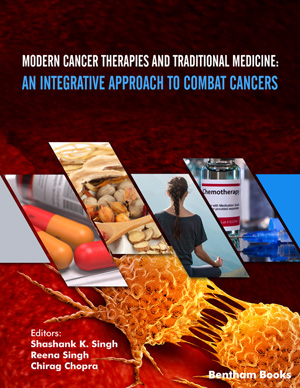
Abstract
Cancer is a condition in which aberrant cells continue to divide uncontrollably, causing tissue to be destroyed. Different cancer stages have been identified by researchers, suggesting that a number of gene alterations are involved in the etiology of cancer. Unusual cell proliferation is brought on by these gene alterations. A crucial role in the acceleration of cell proliferation is played by genetic diseases brought on by heredity or hereditary factors. Its diagnosis and treatment have historically been regarded as two of the most important and significant clinical concerns. Depending on the nature and stage of the tumor, numerous ways to its corrective therapy have been established. Numerous biomolecules derived from plants are crucial for the treatment of the disease. In this review, we focus on specific aspects to give a brief overview of the major problems, including their etiology, therapies that are available, herbal alternates, available vaccines and relevant biomarkers. It was felt that much work needs to be done on combination therapy development and platform optimization.
Graphical Abstract
[http://dx.doi.org/10.3322/caac.21166] [PMID: 23335087]
[http://dx.doi.org/10.3390/ijms18020308] [PMID: 28146134]
[http://dx.doi.org/10.1007/978-3-030-63749-1_2] [PMID: 34019159]
[http://dx.doi.org/10.1007/s11095-008-9661-9] [PMID: 18626751]
[PMID: 23304670]
[http://dx.doi.org/10.1101/cshperspect.a003236] [PMID: 20719876]
[PMID: 19333864]
[http://dx.doi.org/10.1021/np030420c] [PMID: 14987065]
[http://dx.doi.org/10.3389/fgene.2015.00157] [PMID: 25954303]
[http://dx.doi.org/10.3390/medsci6020031] [PMID: 29652830]
[http://dx.doi.org/10.1016/j.immuni.2016.09.001] [PMID: 27653600]
[http://dx.doi.org/10.1073/pnas.0334858100] [PMID: 12552134]
[http://dx.doi.org/10.1177/1947601911408889] [PMID: 21779514]
[http://dx.doi.org/10.1016/0378-8741(95)01255-C] [PMID: 7500639]
[http://dx.doi.org/10.1111/j.1365-2710.2009.01096.x] [PMID: 20175810]
[http://dx.doi.org/10.5138/ijaps.2010.0976.1055.01003]
[http://dx.doi.org/10.3892/etm.2015.2895] [PMID: 26889234]
[http://dx.doi.org/10.1016/j.phrs.2004.04.010] [PMID: 15519531]
[http://dx.doi.org/10.4103/0974-8490.75463] [PMID: 21713145]
[http://dx.doi.org/10.4103/0973-6131.85485] [PMID: 22022122]
[http://dx.doi.org/10.2174/187152012803833026] [PMID: 22583408]
[http://dx.doi.org/10.1089/acm.2013.0259] [PMID: 24341342]
[http://dx.doi.org/10.4103/jfmpc.jfmpc_161_20] [PMID: 32754525]
[http://dx.doi.org/10.3390/cancers3033279] [PMID: 24212956]
[http://dx.doi.org/10.20517/2394-4722.2018.83]
[http://dx.doi.org/10.1016/j.bbcan.2009.11.002] [PMID: 19931353]
[http://dx.doi.org/10.1038/nature10762] [PMID: 22258609]
[http://dx.doi.org/10.1016/S0304-3835(00)00532-2] [PMID: 10974407]
[http://dx.doi.org/10.1093/jnci/93.14.1062] [PMID: 11459867]
[http://dx.doi.org/10.3978/j.issn.2218-676X.2015.06.04] [PMID: 26213686]
[http://dx.doi.org/10.7314/APJCP.2013.14.7.4041] [PMID: 23991949]
[http://dx.doi.org/10.1038/s41568-021-00346-0] [PMID: 33907315]
[http://dx.doi.org/10.2174/138920008785821657] [PMID: 18781909]
[http://dx.doi.org/10.7150/ijms.3635] [PMID: 22408567]
[http://dx.doi.org/10.1177/20503121211034366] [PMID: 34408877]
[PMID: 33489447]
[http://dx.doi.org/10.1136/bmj.2.4993.626] [PMID: 13356034]
[http://dx.doi.org/10.3390/biom12081021] [PMID: 35892331]
[http://dx.doi.org/10.1200/PO.18.00258] [PMID: 35100683]
[http://dx.doi.org/10.5001/omj.2016.19] [PMID: 27168918]
[http://dx.doi.org/10.18632/oncotarget.20189] [PMID: 29113417]
[http://dx.doi.org/10.3322/caac.20114] [PMID: 21617154]
[PMID: 30186799]
[http://dx.doi.org/10.1188/15.ONF.E269-E278] [PMID: 25901389]
[http://dx.doi.org/10.1016/j.molonc.2012.01.010] [PMID: 22356776]
[http://dx.doi.org/10.1634/theoncologist.2008-0184] [PMID: 18987048]
[http://dx.doi.org/10.3390/antib9030034] [PMID: 32698317]
[http://dx.doi.org/10.1021/acs.chemrev.9b00472] [PMID: 31804810]
[http://dx.doi.org/10.3390/vaccines8040615] [PMID: 33080888]























